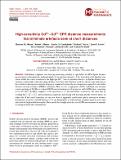Files in this item
High-sensitivity Gd3+-Gd3+ EPR distance measurements that eliminate artefacts seen at short distances
Item metadata
| dc.contributor.author | El Mkami, Hassane | |
| dc.contributor.author | Hunter, Robert I. | |
| dc.contributor.author | Cruickshank, Paul A. S. | |
| dc.contributor.author | Taylor, Michael J. | |
| dc.contributor.author | Lovett, Janet E. | |
| dc.contributor.author | Feintuch, Akiva | |
| dc.contributor.author | Qi, Mian | |
| dc.contributor.author | Godt, Adelheid | |
| dc.contributor.author | Smith, Graham M. | |
| dc.date.accessioned | 2020-12-14T17:30:07Z | |
| dc.date.available | 2020-12-14T17:30:07Z | |
| dc.date.issued | 2020-12-09 | |
| dc.identifier | 269565047 | |
| dc.identifier | 976900a4-be6a-49b3-be6b-5764e37c782b | |
| dc.identifier | 85103277126 | |
| dc.identifier.citation | El Mkami , H , Hunter , R I , Cruickshank , P A S , Taylor , M J , Lovett , J E , Feintuch , A , Qi , M , Godt , A & Smith , G M 2020 , ' High-sensitivity Gd 3+ -Gd 3+ EPR distance measurements that eliminate artefacts seen at short distances ' , Magnetic Resonance , vol. 1 , no. 2 , pp. 301-313 . https://doi.org/10.5194/mr-1-301-2020 | en |
| dc.identifier.issn | 2699-0016 | |
| dc.identifier.other | ORCID: /0000-0002-0552-5784/work/85561970 | |
| dc.identifier.other | ORCID: /0000-0002-0415-9540/work/85562351 | |
| dc.identifier.other | ORCID: /0000-0001-6578-7412/work/85566642 | |
| dc.identifier.other | ORCID: /0000-0002-3561-450X/work/85567563 | |
| dc.identifier.uri | https://hdl.handle.net/10023/21146 | |
| dc.description | We would like to acknowledge EPSRC (EP/R)13705/1) for current funding on the HiPER project, and the Wellcome Trust for a multi-user equipment grant (099149/Z/12/Z) for upgrades on the Q-band system. We thank the Royal Society for an International Exchanges Grant and The Weizmann-UK Joint Research Program for allowing bilateral travel and research between the University of St Andrews and the Weizmann Institute of Science. JEL thanks the Royal Society for a University Research Fellowship. MJT thanks EPSRC for a CM-CDT studentship (EP/LO15110/1). MQ and AG thank the Deutsche Forschungsgemeinschaft (DFG) for funding within SPP 1601 (GO555/6-2). | en |
| dc.description.abstract | Gadolinium complexes are attracting increasing attention as spin labels for EPR dipolar distance measurements in biomolecules and particularly for in-cell measurements. It has been shown that flip-flop transitions within the central transition of the high spin Gd3+ ion can introduce artefacts in dipolar distance measurements, particularly when measuring distances less than 3–4 nm. Previous work has shown some reduction of these artefacts through increasing the frequency separation between the two frequencies required for the Double Electron-Electron Resonance (DEER) experiment. Here we use a high power (1 kW), wideband, non-resonant, system operating at 94 GHz to evaluate DEER measurement protocols using two rigid Gd(III)-rulers, consisting of two [GdIII(PyMTA)] complexes, with separations of 2.1 nm and 6.0 nm, respectively. We show that by avoiding the |−1/2⟩ → |1/2⟩ central transition completely, and placing both the pump and the observer pulses on either side of the central transition, we can now observe apparently artefact-free spectra and narrow distance distributions, even for a Gd-Gd distance of 2.1 nm. Importantly we still maintain excellent signal-to-noise ratio and relatively high modulation depths. These results have implications for in-cell EPR measurements at naturally occurring biomolecule concentrations. | |
| dc.format.extent | 4747802 | |
| dc.language.iso | eng | |
| dc.relation.ispartof | Magnetic Resonance | en |
| dc.subject | Gadolinium (III) | en |
| dc.subject | Spin labels | en |
| dc.subject | ZFS | en |
| dc.subject | Spin flip-flop | en |
| dc.subject | DEER | en |
| dc.subject | QC Physics | en |
| dc.subject | DAS | en |
| dc.subject.lcc | QC | en |
| dc.title | High-sensitivity Gd3+-Gd3+ EPR distance measurements that eliminate artefacts seen at short distances | en |
| dc.type | Journal article | en |
| dc.contributor.sponsor | The Wellcome Trust | en |
| dc.contributor.institution | University of St Andrews. School of Physics and Astronomy | en |
| dc.contributor.institution | University of St Andrews. Biomedical Sciences Research Complex | en |
| dc.identifier.doi | 10.5194/mr-1-301-2020 | |
| dc.description.status | Peer reviewed | en |
| dc.identifier.grantnumber | 099149/Z/12/Z | en |
This item appears in the following Collection(s)
Items in the St Andrews Research Repository are protected by copyright, with all rights reserved, unless otherwise indicated.

